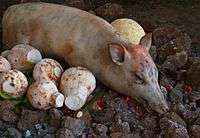Oceanic cuisine

.jpg)

The cuisines of Oceania include those found on Australia, New Zealand, and Tasmania, and also cuisines from many other islands or island groups throughout Oceania. A cuisine is a characteristic style of cooking practices and traditions,[2] often associated with a specific culture.
Australia
Other than by climate and produce availability, Australian cuisine has been influenced by the tastes of settlers to Australia.[3] The British colonial period established a strong base of interest in Anglo-Celtic style recipes and methods. Later influences developed out of multicultural immigration and included Chinese, Japanese, Malaysian, Thai, and Vietnamese cuisines. Mediterranean cuisine influences from Greek cuisine, Italian cuisine, and Lebanese cuisine influences are strong, also influences from French cuisine, Indian cuisine, Spanish cuisine, and Turkish cuisine, German cuisine, and African cuisine. Regional Australian cuisines commonly use locally grown vegetables based on seasonal availability, and Australia also has large fruit growing regions. The Granny Smith variety of apples originated in Sydney, Australia in 1868.[4] In the Southern states of Victoria and South Australia, in particular the Barossa Valley, wines and food reflects the region's traditions and heritage.[5] Australia's climate makes barbecues commonplace. Barbecue stalls selling sausages and fried onion on white bread with tomato or barbecue sauce are common.
Christmas Island
Tasmania
During colonial times typical English cuisine was the standard in most areas of Tasmania. Tasmania now has a wide range of restaurants, in part due to the arrival of immigrants and changing cultural patterns. There are many vineyards throughout Tasmania,[6] and Tasmanian beer brands such as Boags and Cascade are known and sold in Mainland Australia. King Island off the northwestern coast of Tasmania has a reputation for boutique cheeses[6] and dairy products. Tasmanians are also consumers of seafood,[6] such as crayfish, orange roughy, salmon[6] and oysters,[6] both farmed and wild.
- Regional foods
Cook Islands
Easter Island
Fiji
Hawaii
Mariana Islands
New Zealand

New Zealand cuisine is largely based upon local ingredients and seasonal variations.[7] New Zealand is an island nation with a strong agricultural-based economy, and nationally and regionally grown produce and fresh seafood is prominent.[7] The kumara is a type of sweet potato that's been grown in New Zealand for hundreds of years, and is believed to have been imported by early Maori settlers in the mid-13th century.[8] Varieties of kumara include gold, white and red, with red usually the being sweetest.[8] Kiwifruit is a significant part of New Zealand agricultural production.[9] Similar to the cuisine of Australia, the cuisine of New Zealand is a diverse British-based cuisine with Mediterranean and Pacific Rim influences as the country becomes more cosmopolitan. Historical influences came from the Māori culture. New American cuisine, Southeast Asian, East Asian and Indian traditions have become popular since the 1970s.
- Regional foods
- ANZAC biscuits are a sweet biscuit popular in Australia and New Zealand, made using rolled oats, flour, desiccated coconut, sugar, butter, golden syrup, bicarbonate of soda and boiling water.
- A Boston bun/Sally lun is a large spiced bun with a thick layer of coconut icing, prevalent in Australia and New Zealand.
- Hāngi is a traditional New Zealand Māori method of cooking food using heated rocks buried in a pit oven.
- Pavlova is a meringue-based dessert.
Niue
Palau
Samoa
Solomon Islands
Tonga
Tuvalu
Vanuatu
Gallery
- Oceanic foods and dishes
 Granny Smith apples originated in Australia.
Granny Smith apples originated in Australia._(cropped).jpg) A dish from an Australian restaurant
A dish from an Australian restaurant
_1_Luc_Viatour_edit.jpg) Kiwifruit, a well-known New Zealand food
Kiwifruit, a well-known New Zealand food
 A fruit dessert dish in an Australian restaurant
A fruit dessert dish in an Australian restaurant Paniki in yellow soup
Paniki in yellow soup
See also
References
- ↑ Lister, Peter R., Holford, Paul, Haigh, Tony, Morrison, David A. (1996). "Acacia in Australia: Ethnobotany and Potential Food Crop." Purdue University Horticulture & Landscape Architecture. Accessed July 2011.
- ↑ "Cuisine." Thefreedictionary.com. Accessed June 2011.
- ↑ "Australia – Aborigines And White Settlers The Breaking Down of Aboriginal Society." Janesoceania.com. Accessed July 2011.
- ↑ "Granny Smith and her Apples". Archived from the original on 2007-08-11. Retrieved 2007-08-11.
- ↑ "South Australian Food and Wine Tourism Strategy 2009 – 2014." South Australian Tourism Industry Council. Accessed July 2011.
- 1 2 3 4 5 "Tasmania Food & Wine." Goway.com. Accessed July 2011.
- 1 2 "New Zealand's culinary culture." Newzealand.com. Accessed July 2011.
- 1 2 "Iconic Australian & New Zealand Foods." Australianfood.about.com. Accessed July 2011.
- ↑ "About New Zealand Kiwifruit Growers, Inc.. New Zealand Kiwifruit Growers, Inc.. Accessed July 2011.